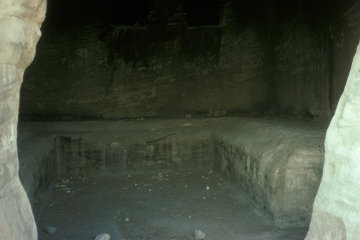Why the Triclinium?

| |
| The interior of the Bab es-Siq triclinium. Diners reclined with their feet against the wall while waiters served the food onto the ledge in front of them. |
One of the first monuments that the visitor to Petra encounters is the Obelisk Tomb and, below it, the Bab el-Siq Triclinium. Those who take the trouble to scramble down into the wadi and up the other side to examine the triclinium find themselves in a room with a wide bench jutting out from the wall on three sides. A ledge has been cut into the bench and the whole thing was for dining. (Doubtless in the days when it was new, the bench was covered with a padded mattress to give diners additional comfort.)
As described by ancient authors from Plato to the Bible, elegant diners in those days reclined on a couch, propping themselves up on their left elbow and reaching for the food with their right hand. This is what the wide bench was for in the triclinium.
Diners lay diagonally across the bench, their feet pressed against the wall of the room and their heads towards the centre of the room. Waiters brought the food into the room and placed it on the ledge - which was a much better arrangement than our western habit of having the waiter reach over your shoulder to serve you. An incautious gesture and you find that your shirt front (if male) or your decolletage (if female) is filled with clear consome!
At first it was thought that these triclinia were for funeral feasts, based on the fact that many of them are near tombs - the proximity of the Bab el-Siq Triclinium to the Obelisk Tomb, for example, or the Roman Soldier Tomb and its triclinium. However more and more of these dining rooms have been identified and it is becoming obvious that, whether or not they served for funerary feasts, they must have had some other purpose as well.
For example, in "Little Petra" there are three large triclinia side by side, which seems a somewhat excessive provision for the small number of tombs there but barely adequate if, as has been suggested, Little Petra was the first stopping place for camel caravans leaving Petra for the north. Those camel drivers had to eat somewhere!
Dr Patricia Bikai of the American Centre of Oriental Research has been excavating in Petra for the last four years but this year her workmen uncovered a 1st century AD underground banqueting hall that had been filled with sand. She suggests that this happened during the earthquake of 363 AD, which seems to me to be unlikely. Sand is moved about in large quantities during sand storms or floods, but not, so far as I am aware, during earthquakes.
Most triclinia are simple rooms with the bench arrangement. The Roman Soldier Triclinium is remarkable for the detailed pilasters and recesses that adorn its walls, and Bikai's discovery is likely to be equally remarkable, in this case because the room was decorated with twenty-two marble heads that once stood on column plinths. Identification of these heads is on-going. It has been suggested that they are gods (though which ones is still not clear) but it is not beyond the realms of possibility that they either were or were intended to be, representations of the ancestors honoured at a funerary feast. (The fact that this banqueting hall is underground is claimed to be further indication that it may have been associated with funerary rites.)
It seems likely that a triclinium served for any communal eating occasion. Funerary feasts were, doubtless, such an occasion, but there were also wedding banquets, guild festivals and so on. Socrates is alleged to have complained that his dining room was very small - only room for six couches; the small houses so far uncovered in Petra would be hard pressed to accommodate even that many, so if you wanted to eat in style with your friends and family, why not hire one of the many banqueting halls - triclinia - in the area and then you could all recline in comfort together?





